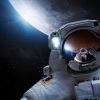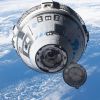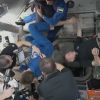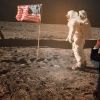-
 +22 +1
+22 +1NASA TV is Live for SpaceX Cargo Dragon Departure
Live coverage of the departure of SpaceX’s uncrewed Dragon cargo spacecraft from the International Space Station is underway on NASA Television, the agency’s website, and the NASA app. Following commands from ground controllers at SpaceX in Hawthorne, California, Dragon will undock at 11:05 a.m. EDT from the forward port of the station’s Harmony module and fire its thrusters to move a safe distance away from the station.
-
 +4 +1
+4 +1NASA to name Artemis 2 crew next week, the first moon astronauts in 50 years
We're a week away from a once-in-a-generation announcement: The names of the first moonbound astronauts in decades. On April 3, NASA and the Canadian Space Agency (CSA) will together showcase the three Americans and one Canadian that will go to the moon on Artemis 2, which will launch no sooner than November 2024. The quartet will loop around the moon during the first-ever human lunar mission since the landing of Apollo 17 in December 1972.
-
 +11 +1
+11 +1Nokia to set up first 4G network on moon with NASA
Nokia's years-long partnership with NASA is finally taking the mobile giant where no cell phone provider has gone before — the moon. There, the Finnish telecommunications company plans to establish the first lunar 4G network, enabling researchers to make new discoveries that could help support the establishment of a human colony on the moon, CNBC reported.
-
 +4 +1
+4 +1Lockheed Martin is building a Moon-to-Earth satellite communications network
If humanity is going to have a long-term presence on the Moon, it's going to need reliable communications — and Lockheed Martin thinks it can provide that link. The company has created a spinoff devoted to lunar infrastructure, Crescent Space, whose first project is a Moon-to-Earth satellite network. Parsec, as it's called, uses a constellation of small lunar satellites to provide a non-stop connection between astronauts, their equipment and the people back home. The system will also provide navigation help.
-
 +11 +1
+11 +1US Space Force wants to test how to build satellites in orbit with $1.6 million Arkisys deal
The U.S. Space Force has inked a deal to build satellites in orbit in a bid to boost space infrastructure. Under the Space Force agreement, the U.S. defense agency's innovation division SpaceWERX has awarded a $1.6 million Direct-to-Phase II SBIR contract to the California-based Arkisys Inc., in collaboration with aerospace partners Qediq Inc, Novawurks, Motive Space Systems, iBoss, and the Texas A&M Engineering Experiment Station (TEES).
-
 +14 +1
+14 +1Hibernation, a closely studied option for extended space travel
Interstellar, Avatar, Alien, and 2001: A Space Odyssey... Four masterpieces of cinema, each made in a different decade, all use the same premise: human hibernation. It is a choice ingredient of films depicting future exploration of the cosmos – for most of us, the stuff of sci-fi. However, Angelique Van Ombergen, head of life sciences at the European Space Agency (ESA), makes it clear: "While for many people hibernation is science fiction, our approach is truly scientific."
-
 +16 +1
+16 +1A scientific salad for astronauts in deep space
The ingredients were chosen for their nutritional value, as well as how easy they’ll be to grow with the limited room and resources available on a spacecraft.
-
 +4 +1
+4 +1NASA unveils new spacesuit with updated tech for new moon missions
On Wednesday morning, an engineer with private space company Axiom walked out onto a stage at NASA’s Johnson Space Center in Houston, smiling from behind a domed helmet and visor. He was demonstrating a prototype of a new spacesuit, intended for use in the Artemis III mission slated for 2025, which will send astronauts back to the moon for the first time in more than half a century.
-
 +14 +1
+14 +1NASA picks Axiom Space for its third astronaut mission to the ISS
NASA has chosen Axiom Space's proposal yet again for the third private astronaut mission to the International Space Station. The two parties have already signed a mission order, and they're hoping to launch sometime in November 2023 and beyond from the Kennedy Space Center in Florida. A more specific date will be announced later, since it will depend on the timing of other flights to the ISS, as well as on in-orbit activity planning.
-
 +16 +1
+16 +1NASA and Axiom Space unveil new spacesuit for Artemis III moon mission
NASA and the Houston-based aerospace company Axiom Space gave CBS News an early look at the spacesuit that astronauts will wear on the Artemis III mission — the first lunar landing of the NASA program returning astronauts to the moon. The suit was officially unveiled at an event in Houston on Wednesday.
-
 +13 +1
+13 +1NASA wants new 'deorbit tug' to bring space station down in 2030
NASA aims to develop a spacecraft capable of steering the International Space Station (ISS) to a controlled destruction in Earth's atmosphere when its time in orbit is up. We first learned about this plan on Thursday (March 9), when the White House released its 2024 federal budget request. NASA's $27.2 billion allocation included $180 million "to initiate development of a new space tug" that could safely deorbit the ISS over the open ocean after its operational life ends in 2030, as well as potentially perform other activities.
-
 +16 +1
+16 +1Biden budget seeks $27.2 billion for NASA, with increases for moon and Mars programs
President Joe Biden is seeking to increase the budget for the National Aeronautics and Space Administration to $27.2 billion next year, according to a proposed 2024 budget released Thursday. The request represents a 7% increase from NASA’s budget in fiscal year 2023, with more funds allocated for the space agency’s Artemis lunar program.
-
 +21 +1
+21 +1NASA's Curiosity rover spots "sun rays" on Mars for the first time
NASA's Curiosity rover has captured "sun rays" on Mars for the first time, the agency says. The footage was taken on Feb. 6, NASA said, and showed the phenomenon as the sun set on the planet. This is the first time, NASA said, that the sun rays, also known as crepuscular rays, have been viewed so clearly.
-
 +3 +1
+3 +1Are telescopes on the Moon doomed before they’ve even been built?
For radioastronomers, the far side of the Moon could be the last unspoilt refuge in the Solar System. Planet Earth — and all the human-made electromagnetic noise it spews out into space — stays permanently below the horizon, so that any radio observatories positioned there would be free to observe the cosmos without interference.
-
 +18 +1
+18 +1SpaceX Crew Dragon capsule docks at space station, delivering three-country, four-man crew for six-month stay
A day after launch from the Kennedy Space Center, a Crew Dragon spacecraft docked at the International Space Station early Friday, bringing two NASA astronauts, a Russian cosmonaut and a United Arab Emirates astronaut to the outpost for a six-month stay.
-
 +24 +1
+24 +1After flying four astronauts into orbit, SpaceX makes its 101st straight landing
A Falcon 9 rocket blasted into the starry sky above Florida early on Thursday morning, sending four astronauts safely on their way into low-Earth orbit. This mission, flown by SpaceX for NASA, will deliver the astronauts to the International Space Station after a 24.5-hour flight to synch up with the orbiting laboratory. During this time, under nominal operations, Dragon will fly entirely autonomously.
-
 +16 +1
+16 +1NASA's Artemis moon program receives salute from Apollo 11's Buzz Aldrin (video)
The second person to walk on the moon can't wait to see new astronauts follow in his footprints. Buzz Aldrin, one of the astronauts of the Apollo 11 mission of 1969, said Thursday (Feb. 23) he is excited to see NASA land people on the moon again as soon as 2025 with its Artemis program.
-
 +20 +1
+20 +1Russia is launching a mission to give stranded space station crew members a ride home
The Russian spacecraft that brought the three crew members to the ISS in the fall later experienced a leak in its radiator cooling loop. A replacement ship is set to be launched on Friday.
-
 +2 +1
+2 +1WATCH: Huge portion of the Sun breaks off from the surface, swirls around its North Pole
Researchers at NASA were baffled when they saw a piece of the Sun, breaking off from its surface and creating a vortex around its North Pole. Scientists are still trying to understand what impact this event will have on Earth, and when.
-
 +22 +1
+22 +1Sierra Space Tests Another Inflatable Space Station Module ... to Destruction
Oops! They’ve done it again. Sierra Space blew up their space habitat for the third time – intentionally — all in the name of testing. The commercial space company conducted a new duration test called an Accelerated Systematic Creep Test for their LIFE Habitat (Large Integrated Flexible Environment), putting a 1/3 size scale model of the space module under gradually increasing excess pressure until it failed. The habitat burst after more than 150 hours of constant pressure, exceeding NASA’s certification target of 100 hours.
Submit a link
Start a discussion




















